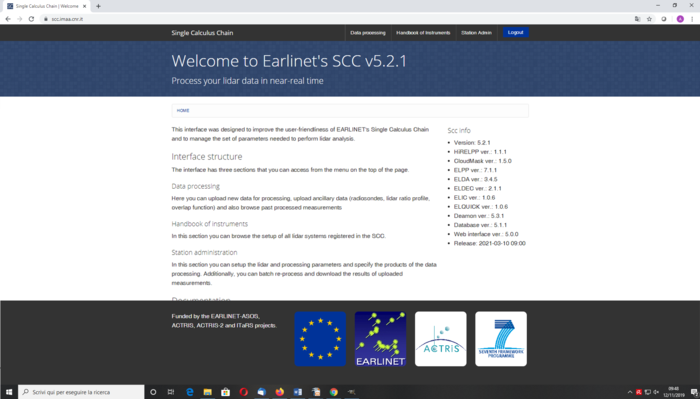



The EARLINET Single Calculus Chain (SCC) is a tool for the automatic analysis of aerosol lidar measurements. The development of this tool started in the framework of EARLINET-ASOS (European Aerosol Research Lidar Network – Advanced Sustainable Observation System), it was extended and still on going under the ACTRIS (Aerosol, Clouds and Trace gases Research InfraStructure Network) umbrella. The SCC is a major component of the ACTRIS Aeorosol Remote Sensing Node (ARES) responsible for the curation and the processing of the ACTRIS aerosol remote sensing data.
The main aim of SCC is to provide any ACTRIS compliant lidar station with a quality controlled data processing chain to retrieve vertical profiles of important aerosol optical parameters like the aerosol backscatter and extinction coefficient profiles, volume and particle depolarization ratio profiles in a fully automatic way. To ensure ensure the full traceability in the data processing, raw data (NetCDF format) need to be submitted to the SCC. Moreover, all the input parameters needed to perform the lidar analysis are stored in a database keeping track of all changes which may occur over the time.
The SCC is offered as external service to non ACTRIS lidar stations. The end-user can interact with the SCC via a user-friendly web interface. All SCC modules are developed using open-source and freely available software packages.
The high-quality of the SCC products is proven by the good agreement between the SCC analysis, and the corresponding independent manual retrievals. Finally, the ability of the SCC to provide high-quality aerosol optical products is demonstrated for an EARLINET intense observation period.
According to the ACTRIS definition of data levels, Level 0 products are raw data, Level 1 products are retrieved from Level 0 products and are compliant with basic quality control procedures and Level 2 products are fully quality controlled products.
The SCC ingests as input Level 0 lidar products and produces Level 1 and/or Level 2 products.
All the Level 1/Level 2 SCC products are in netCDF format and are compliant with the CF conventions (http://cfconventions.org).
Specifically, the following products are generated automatically:
pre-processed (un-calibrated) range corrected time series at instrumental vertical and time resolution (high resolution). If the lidar instrument has polarization capabilities the volume linear depolarization ratio is provided as well.
2D high resolution cloudmask grid (x axis: time y axis: altitude), in which each pixel is flagged as cloud free or cloud contaminated.
low resolution pre-processed (un-calibrated) range corrected time series.
low resolution aerosol optical products (aerosol backscatter/extinction coefficient, volume/particle depolarization ratio).
high/low resolution total attenuated backscatter and volume depolarization ratio timeseries.
standardized lidar quicklook (png images) representing high resolution timeseries of total attenuated backscatter and/or volume depolarization timeseries.
Two possible types of access are possible:
- access via GUI (https://scc.imaa.cnr.it). This is used to provide/manage all the input parameters needed for the data analysis, to upload/download SCC products manually, to monitor the data processing.
- access via API (https://scc.imaa.cnr.it/api/v1). The API is used to submit raw data to the SCC in a fully automatic way. The same API can be used to get SCC products and to monitor data processing. A Python based client for the SCC API is available at https://repositories.imaa.cnr.it/public/scc_access/.
A general username and password is needed for accessing both the SCC GUI and API. After a successful authentication a second (specific) log-in is needed in order to access and to effective use the SCC. Each SCC user account is linked to one or more lidar stations and can manage data analysis for all the lidar(s) operative at the station(s) the account is connected to.
- Official documentation can be found at https://docs.scc.imaa.cnr.it
- You can post your questions and comments on the EARLINET forum (https://earlinetforum.imaa.cnr.it/viewforum.php?f=21) where SCC problems are discussed and several suggestions can be found. If you don't have account, you can register (https://earlinetforum.imaa.cnr.it/ucp.php?mode=register) using your full name and using an institutional email.
- For ACTRIS/EARLINET lidar stations: the registration is automatic as soon as an ACTRIS lidar code has been assigned to the station. If you want to join EARLINET, visit "Joining EARLINET" page.
- For non ACTRIS/EARLINET lidar stations: the usage/testing of the SCC is possible also for not ACTRIS stations! If you are interested, please, request the access to SCC as ACTRIS DC-ARES service following ACTRIS-IMP instructions at https://www.actris.eu/access-services/apply-tna and guide https://www.actris.eu/sites/default/files/inline-files/Guidance%20notes%20to%20ACTRIS%20IMP%20user%20application%20form%202021.pdf.
The SCC input files format can be checked using a command-line python script hosted here.
SCC raw input files can be generated using a command-line python script hosted here (the main supported format is Licel binary files, including the Raymetrics modified format).
D'Amico, G., Amodeo, A., Baars, H., Binietoglou, I., Freudenthaler, V., Mattis, I., Wandinger, U., and Pappalardo, G.: EARLINET Single Calculus Chain – overview on methodology and strategy, Atmos. Meas. Tech., 8, 4891-4916, doi:10.5194/amt-8-4891-2015, 2015
D'Amico, G., Amodeo, A., Mattis, I., Freudenthaler, V., and Pappalardo, G.: EARLINET Single Calculus Chain – technical – Part 1: Pre-processing of raw lidar data, Atmos. Meas. Tech., 9, 491-507, doi:10.5194/amt-9-491-2016, 2016
Mattis, I., D'Amico, G., Baars, H., Amodeo, A., Madonna, F., and Iarlori, M.: EARLINET Single Calculus Chain – technical – Part 2: Calculation of optical products, Atmos. Meas. Tech., 9, 3009-3029, doi:10.5194/amt-9-3009-2016, 2016